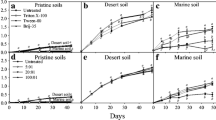Abstract
We have used a simple technique to measure the detergency of model oily soil from 63∶35 blended polyester/cotton fabrics using solutions of commercial linear lauryl alcohol ethoxylates in the vicinity of their phase inversion temperatures (PIT). The method involves incorporation of an oil-soluble dye in the oily soil, and measurement of reflectance at an appropriate wavelength directly on the fabric before and after wash. This technique was validated for our systems, and it provides an additional visual cue for the efficiency of soil removal. Hexadecane, which represents the linear hydrocarbon part of sebum (typical soil encountered in detergency) and has been widely studied in the literature, was used as the model oily soil. Maximal detergency occurs as a function of washing temperature at approximately 35, 62, and 80°C for ethoxylates with four, five, and six moles of ethylene oxide (C12EO4, C12EO5, and C12EO6), respectively. The oil/water interfacial tension, measured using the spinning drop method, exhibits corresponding minima and complements the detergency results. Addition of sodium carbonate, a salting-out electrolyte, decreases the optimal detergency temperature (ODT) of C12EO5, shifting its behavior toward C12FO4 whereas addition of anionic surfactant increases the ODT of C12FO5, mimicking the behavior of a higher ethoxylate.
Similar content being viewed by others
References
Thompson, L., The Role of Oil Detachment Mechanisms in Determining Optimum Detergency Conditions, J. Colloid Interface Sci. 163:61–73 (1994).
Kissa, E., Kinetics and Mechanisms of Soiling Detergency, in Detergency: Theory and Practice, edited by W.G. Cutler and E. Kissa, Surfactant Science Series, Marcel Dekker, New York, 1987, Vol. 20, p. 258.
Corkill, J.M., J.F. Goodman, and J.R. Tate, Adsorption of Nonionic Surface-Active Agents at the Graphon/Solution Interface, Trans. Faraday Soc. 62:979–986 (1967).
Kahlweit, M., and R. Strey, The Phase Behavior of H2O-Oil-Nonionic Amphiphile Ternary Systems, in Microemulsion Systems, edited by H.L. Rosano and M. Clausse, Surfactant Science Series, Marcel Dekker, New York, 1987, Vol. 24, pp. 1–13.
Raney, K.H., Optimization of Nonionic/Anionic Surfactant Blends for Enhanced Oily Soil Removal, J. Am. Oil Chem. Soc. 68:525–531 (1991).
Raney, K.H., W.J. Benton, and C.A. Miller, Optimum Detergency Conditions with Nonionic Surfactants: I—Ternary Water-Surfactant-Hydrocarbon Systems J. Colloid Interface Sci. 117:282–290 (1987).
Raney K.H., and C.A. Miller, Optimum Detergency Conditions with Nonionic Surfactants—II—Effect of Hydrophobic Additives, Colloids Surf.—A: Physicochem. Eng. Aspects 74:169–215 (1993).
Dillan, K.W., Effects of the Ethylene Oxide Distribution on Nonionic Surfactant Properties, J. Am. Oil Chem. Soc. 1144–1151 (1985).
Cox, M.F., The Effect of “Peaking” the Ethylene Oxide Distribution on the Performance of Alcohol Ethoxylates and Ether Sulfates,-—Ibid. 67:599–604 (1990).
Raney, K.H., and H.L. Benson, The Effect of Polar Soil Components on the Phase Inversion Temperature and Optimum Detergency Conditions,-—Ibid. 67:722–729 (1990).
Hreczuch, W., G. Bekierz, and J. Szymanowski, Homologue Distribution of Alcohol Ethoxylates, Tenside Surfactants Deterg. 32:55–60 (1995).
Arai, H., and K. Shinoda, The Effect of Mixing of Oils and of Nonionic Surfactants on the Phase Inversion Temperatures of Emulsions, J. Colloid Interface Sci. 25:396–400 (1967).
Cox, M.F., Effect of Alkyl Carbon Chain Length and Ethylene Oxide Content on the Performance of Linear Alcohol Ethoxylates, J. Am. Oil Chem. Soc. 66:367–374 (1989).
Kissa, E., A Reproducible Method for the Evaluation of Soil Release Tex. Chem. Color. 3:224 (1971).
Hydroxyl Value, AOCS Official Methods and Recommended Practices, 4th edn., AOCS Press, Champaign, 1993, Vol. 1, Cd 13–60.
Rosen, M.J., Surfactants and Interfacial Phenomena, 2nd edn., John Wiley & Sons, New York, 1989, p. 328.
Shinoda, K., and H. Arai, The Correlation Between Phase Inversion Temperature in Emulsion and Cloud Point in Solution of Nonionic Emulsifier, J. Phys. Chem. 68,3485–3490 (1964).
Marszall, L., HLB of Nonionic Surfactants: PIT and EIP Methods, in Nonionic Surfactants: Physical Chemistry, edited by M.J. Schick, Surfactant Science Series, Marcel Dekker, New York, 1987, Vol. 23, pp. 493–547.
Kahlweit, M., R. Strey and D. Haase, Phase Behaviour of Multicomponent Systems Water-Oil-Amphiphile-Electrolyte—3, J. Phys. Chem. 89:163–171 (1985).
Author information
Authors and Affiliations
About this article
Cite this article
Goel, S.K. Measuring detergency of oily soils in the vicinity of phase inversion temperatures of commercial nonionic surfactants using an oil-soluble dye. J Surfact Deterg 1, 221–226 (1998). https://doi.org/10.1007/s11743-998-0023-5
Received:
Accepted:
Issue Date:
DOI: https://doi.org/10.1007/s11743-998-0023-5




